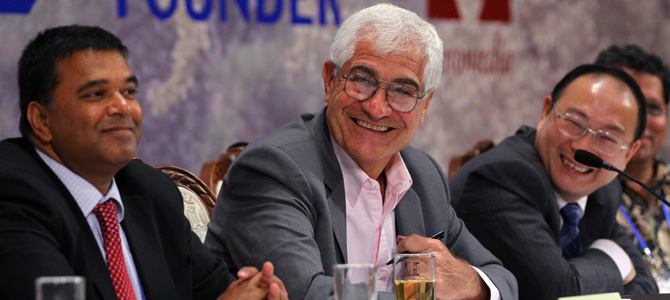
LHASA - A multi-metal mine in the birthplace of Tibetan King Songtsen Gampo has the potential to be among the world's 50 biggest mines of its kind by deposits and may generate an annual product value of 4.5 billion yuan ($712 million) by the end of 2015, Chinese prospectors have announced.
Medrogungkar county, home to the Jiama Copper Gold Polymetallic Mine, about 68 kilometers from Lhasa, may dethrone Dexing in East China's Jiangxi province to become the country's biggest copper town in 10 years, said Jiang Liangyou, board chairman and Party secretary of the owner of the mine, Tibet Huatailong Mining Development.
The projections were based upon the initial prospecting finished by Huatailong in 2010 within a land area of nine square kilometers, Jiang said. The company's mining permit covers a total area of 144 square kilometers at an altitude of 4,000 to 5,407 meters.
"The prospecting results are subject to independent third-party verification overseas," he said. "If verified, it would propel the mine into its second-phase expansion."
According to the expansion feasibility report that has already been completed, the subsidiary of the China Gold International Resources Co Ltd would expand its daily processing capacity from the current 6,000 tons of ore to 40,000 tons since the end of 2015 for 70 years.
"Phenomenal changes will be brought to Tibet's economic and social development, because, after the expansion, Jiama Mine may generate tax revenue equivalent to one-sixth of the current fiscal revenue of the government of Tibet autonomous region," said Jiang.
Official statistics show that Tibet took in record-high tax revenue of 9.663 billion yuan in 2011, up 91 percent year on year. Last year, Medrogungkar became the first Tibetan county to rake in tax revenue of more than 200 million yuan. Also last year, Huatailong posted revenues of about 660 million yuan from its main business and 140 million yuan in profits, and the company paid 118 million yuan in taxes.
First-phase production started in July 2010 with a total investment of 3.5 billion yuan, and the largest copper gold polymetallic mine in Tibet specializes in the exploitation and processing of six metals - namely, copper, lead, zinc, gold, silver and molybdenum.
Industrial weathervane
Located within the Gangdise Copper Metallogeny Belt in central Tibet, the Jiama project has been developing amid disputes. Before the mining area was taken over by Huatailong under the state-owned China National Gold Group Corporation in late 2009, a dozen private miners were caught up in a rat race for the rich ore supplies, ignoring their responsibilities to the local community and environment.
Ensuing public complaints forced the regional government to suspend the operations of the private miners, re-examine the local mining industry and seek a proper way to develop Tibet into "a reserve base of strategic resources" as the central government had required in January 2010.
Although nine key mining zones, including Jiama, had been officially designated as such years before, the local mining industry contributed to less than 3 percent of the region's total gross domestic product and was heavily criticized for jeopardizing the ecology and environment of the "roof of the world."
"As the only mining company parented by a centrally-administered enterprise in Tibet, Huatailong has been challenged to lead the industry by the regional government, blazing an appropriate trail to honor its social responsibility in Tibet and bring local residents long-lasting benefits through environmental protection and community-building efforts," said Sun Zhaoxue, general manager of CNGG.
"The answer, in our mind, is to build Jiama into a large, environmentally-friendly mine equipped with leading technologies," he said.


 Washington to remain focused on Asia-Pacific
Washington to remain focused on Asia-Pacific RQFII target blue chips amid bear market
RQFII target blue chips amid bear market Australian recall for top two exporters
Australian recall for top two exporters China fears new car restrictions
China fears new car restrictions